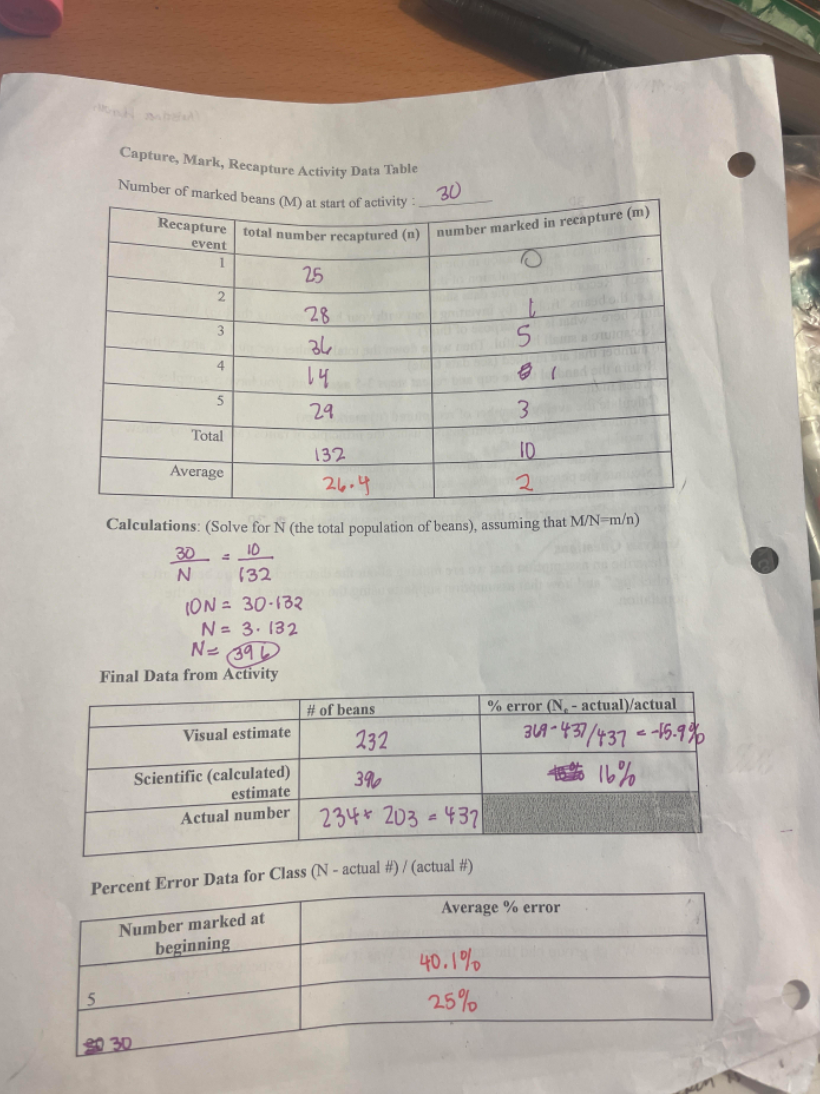Describe an assumption that we are making about the distribution of the beans after “frolicking,” and how that assumption supports using the recapture sample to estimate the population. If the reality does not match the assumption made above, explain how that could result in an estimate that is different from the real population.
Describe an assumption that we are making about the distribution of the beans after “frolicking,” and how that assumption supports using the recapture sample to estimate the population. If the reality does not match the assumption made above, explain how that could result in an estimate that is different from the real population.
Algebra & Trigonometry with Analytic Geometry
13th Edition
ISBN:9781133382119
Author:Swokowski
Publisher:Swokowski
Chapter7: Analytic Trigonometry
Section7.3: The Addition And Subtraction Formulas
Problem 76E
Related questions
Question
Ratio Application to Population Estimation: Capture, Mark, Release, Recapture Activity
Procedure
- Take 5 or 20 brown beans (you will be assigned). These represent your marked beans (the variable M). Record this # on the data sheet.
- Add them to the population in the cup. Mix them into the beans in the cup, and make a visual estimate of the population of the beans (which includes the ones that you just added). Record this # on the data sheet.
- Let the beans "frolic" (by inverting them with your hand covering the top) 10 times (think here - what is the purpose of this?).
- Recapture a small handful. Then write down the total number recaptured, and of those, the number that are marked (see data table).
- Return the handful to the cup and repeat steps 3-5 again until you have 5 samples recorded in the table.
- Calculate the average number of recaptured (n) marked (m).
- Calculate your scientific estimate (Ne) using the principle of ratios (M/Ne=m/n). Show your work!
- Then count the beans. Write down the actual number.
- Calculate the percent error: (Ne – actual #)/(actual#)
- When instructed, share your data for an analysis of how the % errors for those who marked 5 compared to the % errors for those who marked 20.
Analysis Questions
- Describe an assumption that we are making about the distribution of the beans after “frolicking,” and how that assumption supports using the recapture sample to estimate the population. If the reality does not match the assumption made above, explain how that could result in an estimate that is different from the real population.

Transcribed Image Text:Recapture total number recaptured (n) number marked in recapture (m)
Capture, Mark, Recapture Activity Data Table
Number of marked beans (M) at start of activity
30
event
1
25
28
3
4
5
29
3
Total
132
I0
Average
26.4
2.
Calculations: (Solve for N (the total population of beans), assuming that M/N-m/n)
10
(32
30
(ON = 30-132
N= 3. 132
Final Data from Activity
# of beans
% error (N, - actual)/actual
31A - 437/437 - -15.9%
Visual estimate
232
Scientific (calculated)
estimate
16%
396
234* 203 =437
Actual number
Percent Error Data for Class (N - actual #) / (actual #)
Average % error
Number marked at
beginning
40.1%
25%
20 30
Expert Solution
This question has been solved!
Explore an expertly crafted, step-by-step solution for a thorough understanding of key concepts.
Step by step
Solved in 2 steps

Recommended textbooks for you

Algebra & Trigonometry with Analytic Geometry
Algebra
ISBN:
9781133382119
Author:
Swokowski
Publisher:
Cengage

Functions and Change: A Modeling Approach to Coll…
Algebra
ISBN:
9781337111348
Author:
Bruce Crauder, Benny Evans, Alan Noell
Publisher:
Cengage Learning

Algebra & Trigonometry with Analytic Geometry
Algebra
ISBN:
9781133382119
Author:
Swokowski
Publisher:
Cengage

Functions and Change: A Modeling Approach to Coll…
Algebra
ISBN:
9781337111348
Author:
Bruce Crauder, Benny Evans, Alan Noell
Publisher:
Cengage Learning